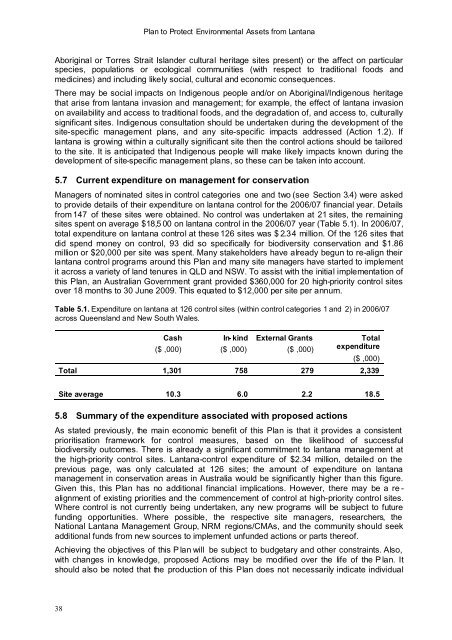Plan to Protect Environmental Assets from Lantana - Weeds Australia
Plan to Protect Environmental Assets from Lantana - Weeds Australia
Plan to Protect Environmental Assets from Lantana - Weeds Australia
You also want an ePaper? Increase the reach of your titles
YUMPU automatically turns print PDFs into web optimized ePapers that Google loves.
<strong>Plan</strong> <strong>to</strong> <strong>Protect</strong> <strong>Environmental</strong> <strong>Assets</strong> <strong>from</strong> <strong>Lantana</strong><br />
Aboriginal or Torres Strait Islander cultural heritage sites present) or the affect on particular<br />
species, populations or ecological communities (with respect <strong>to</strong> traditional foods and<br />
medicines) and including likely social, cultural and economic consequences.<br />
There may be social impacts on Indigenous people and/or on Aboriginal/Indigenous heritage<br />
that arise <strong>from</strong> lantana invasion and management; for example, the effect of lantana invasion<br />
on availability and access <strong>to</strong> traditional foods, and the degradation of, and access <strong>to</strong>, culturally<br />
significant sites. Indigenous consultation should be undertaken during the development of the<br />
site-specific management plans, and any site-specific impacts addressed (Action 1.2). If<br />
lantana is growing within a culturally significant site then the control actions should be tailored<br />
<strong>to</strong> the site. It is anticipated that Indigenous people will make likely impacts known during the<br />
development of site-specific management plans, so these can be taken in<strong>to</strong> account.<br />
5.7 Current expenditure on management for conservation<br />
Managers of nominated sites in control categories one and two (see Section 3.4) were asked<br />
<strong>to</strong> provide details of their expenditure on lantana control for the 2006/07 financial year. Details<br />
<strong>from</strong>147 of these sites were obtained. No control was undertaken at 21 sites, the remaining<br />
sites spent on average $18,5 00 on lantana control in the 2006/07 year (Table 5.1). In 2006/07,<br />
<strong>to</strong>tal expenditure on lantana control at these 126 sites was $ 2.34 million. Of the 126 sites that<br />
did spend money on control, 93 did so specifically for biodiversity conservation and $1.86<br />
million or $20,000 per site was spent. Many stakeholders have already begun <strong>to</strong> re-align their<br />
lantana control programs around this <strong>Plan</strong> and many site managers have started <strong>to</strong> implement<br />
it across a variety of land tenures in QLD and NSW. To assist with the initial implementation of<br />
this <strong>Plan</strong>, an <strong>Australia</strong>n Government grant provided $360,000 for 20 high-priority control sites<br />
over 18 months <strong>to</strong> 30 June 2009. This equated <strong>to</strong> $12,000 per site per annum.<br />
Table 5.1. Expenditure on lantana at 126 control sites (within control categories 1 and 2) in 2006/07<br />
across Queensland and New South Wales.<br />
Cash<br />
($ ,000)<br />
In- kind<br />
($ ,000)<br />
External Grants<br />
($ ,000)<br />
Total<br />
expenditure<br />
($ ,000)<br />
Total 1,301 758 279 2,339<br />
Site average 10.3 6.0 2.2 18.5<br />
5.8 Summary of the expenditure associated with proposed actions<br />
As stated previously, the main economic benefit of this <strong>Plan</strong> is that it provides a consistent<br />
prioritisation framework for control measures, based on the likelihood of successful<br />
biodiversity outcomes. There is already a significant commitment <strong>to</strong> lantana management at<br />
the high-priority control sites. <strong>Lantana</strong>-control expenditure of $2.34 million, detailed on the<br />
previous page, was only calculated at 126 sites; the amount of expenditure on lantana<br />
management in conservation areas in <strong>Australia</strong> would be significantly higher than this figure.<br />
Given this, this <strong>Plan</strong> has no additional financial implications. However, there may be a re -<br />
alignment of existing priorities and the commencement of control at high-priority control sites.<br />
Where control is not currently being undertaken, any new programs will be subject <strong>to</strong> future<br />
funding opportunities. Where possible, the respective site managers, researchers, the<br />
National <strong>Lantana</strong> Management Group, NRM regions/CMAs, and the community should seek<br />
additional funds <strong>from</strong> new sources <strong>to</strong> implement unfunded actions or parts thereof.<br />
Achieving the objectives of this P lan will be subject <strong>to</strong> budgetary and other constraints. Also,<br />
with changes in knowledge, proposed Actions may be modified over the life of the P lan. It<br />
should also be noted that the production of this <strong>Plan</strong> does not necessarily indicate individual<br />
38

















